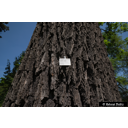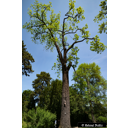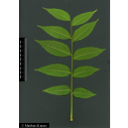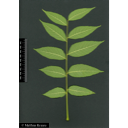Useful information about the taxon (species, subspecies, variety...)
Juglans nigra L. 1753
Juglandaceae
(APG III)Black walnut, American walnut
Akzessionnummer: EG-D-053-16930
Pflanzjahr: 1954
Patenschaftstext: Zum 60. Geburtstag für Andreas Purucker von seinen Kollegen
Taxon concept: The Plant List (2014), version 1.1
Distribution: Canada: Ontario; USA: northeastern, northern and southern States of the Great Plains, southeastern, Florida
Flowering period: IV - VI
Juglans nigra L. - Accepted: Juglans nigra L. bei Zander 2008; Familie: Juglandaceae (Zander 2008)Juglans nigra L. - Accepted: Juglans nigra L. bei BfN Checklist Flora DE; Familie: Juglandaceae (APG IV)
- Flowers
- monoecious, dichogamous
- Flower ecology
- wind-pollinated (anemophilous)
- Life form
- tree
- Leaves
- pinnately compound
- Foliage persistence
- deciduous
- Fruits
- nuts with hard, black shells
- Fruit ecology
- gravity-dispersed (barochorous) and animal-dispersed (zoochorous)
- Soil conditions
- preferentially on deep, well-drained, nearly neutral, fertile loam, loess, and alluvial soils
- Root type
- deep-rooted (large taproot)
- Natural occurrence (habitat)
- along streams, north- or east-facing lower slopes, floodplains, occasionally in oak forests
- Vegetation typ and synecology (plant community)
- temperate mixed mesophytic deciduous forests; associated with e.g. yellow-poplar, white ash or Kentucky coffeetree
- Usage
- wood is used for diverse fine furniture, interior paneling, and gunstocks; nuts are edible and used for candies, baked goods and ice cream
- Phytopathogenic organisms
- foliage is affected by different leaf spot diseases caused by the fungi Cristulariella pyramidalis and Mycosphaerella juglandis
Erhardt, W., Götz, E., Bödeker, N. & Seybold, S. (2008): Der große Zander. Enzyklopädie der Pflanzennamen. Band 2. Arten und Sorten. Eugen Ulmer KG, Stuttgart (Hohenheim), 18. Aufl., 2103 S.; Howard, J. L. (1992): Umbellularia californica. In: Fire Effects Information System, [Online]. U.S. Department of Agriculture, Forest Service, Rocky Mountain Research Station, Fire Sciences Laboratory (Producer). See: https://www.fs.fed.us/database/feis/plants/tree/umbcal/all.html; The International Plant Names Index (2009). Published on the Internet http://www.ipni.org; Courtesy to IPNI, 2009. Exported from IPNI at date: 2009-09-22 20:17:51; The IUCN Red List of Threatened Species. www.iucnredlist.org;
Diese Webseite verwendet Google Maps, um Karten und Standorte von Pflanzen in den Hohenheimer Gärten anzuzeigen. Dadurch werden unter Umständen Daten an Google weitergeleitet, was mit einer Verarbeitung Ihrer personenbezogenen Daten verbunden sein kann. Die Datenschutzerklärung von Google finden Sie hier: Datenschutzerklärung von Google




